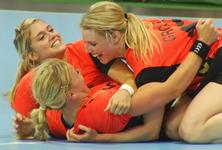The ‘other’ continents had already established their participation. Africa has four slots, because Angola, like Brazil for PanAmerica, earned an extra one. Their teams are Angola, Tunisia (who have progressed a lot in recent years), D.R. Congo, and Algeria. Australia is the ‘usual’ representative for Oceania. Asia has three slots, all of which were taken by East Asian teams: Korea, China and Japan. So after the PanAmerican contingency is now known to be Brazil, Argentina, the Dominican Republic and Paraguay, it was up to Europe to fill the remaining slots.
The European Handball Federation (EHF) generally takes an easy way out when it comes to World Championship qualifying. It is not a secret that the EHF would prefer to have this qualifying based directly on the results of the most recent European Championship, which is really the approach taken in the other continents. And is also seen as a burden for the teams, especially on the men’s side, if full-fledged qualifying through group play, which is the approach used for the European Championship, were to be organized.
So the current method is a compromise, under which the three medal winners (Montenegro, Norway and Hungary) are directly qualified together with the host country Serbia. The remaining participants from the previous European Championship then enter straight into a home and away ‘knock out’ competition together with the survivors from a qualifying event among the ‘lesser’ nations. This approach really depends a bit much on the luck of the draw, together with the caprices of playing just two games. So the losers tend to find it a bit of a ‘double whammy’, as their chances of coming back next time will depend mostly on the draw and the risk of encountering one of the top teams.
This time, as always happens, there were a couple of surprises. Sweden had been a perennial participant in World and European Championships for a number of years now, but this time they were weaker than usual and got kicked out by Poland. But the real surprise was the elimination of Russia, who found themselves on the outside for the first time in many decades. They seemed to have it all sewn up after an away win against the Netherlands, but the Dutch women shocked everyone with an amazing 33-21 victory in the return game. France had to struggle a bit, getting only a tie at home against Croatia, but they came back stronger in the away game. The remaining match-ups had a clearer outcome.
One might now have liked to see some really exciting groups after today’s draw for the World Championship, but I think most people will find the groupings rather boring and predictable. Presumably we will in the end be in for some surprise(s), but I would be hard pressed to speculate about one. The format is such that the four best teams in each group will qualify for the round of 16, with group winners each encountering a fourth-placed team etc. In almost every group it seems rather clear which four teams will advance, and only the internal ranking among them would then be the cause of some suspense. One might wish for teams such as Argentina or Tunisia to surprise a higher-ranked team, but for now it seems that the only battle will be in group B between rivals China and Japan. Here are the complete groups so that you can start your own speculation and possibly disagree with me:
A: Montenegro, Netherlands, France, Korea, D.R. Congo, Dominican Republic
B: Denmark, Brazil, Serbia, China, Japan, Algeria
C: Norway, Poland, Angola, Spain, Argentina, Paraguay
D: Hungary, Germany, Romania, Czech Republic, Tunisia, Australia

